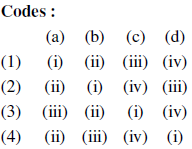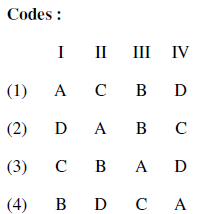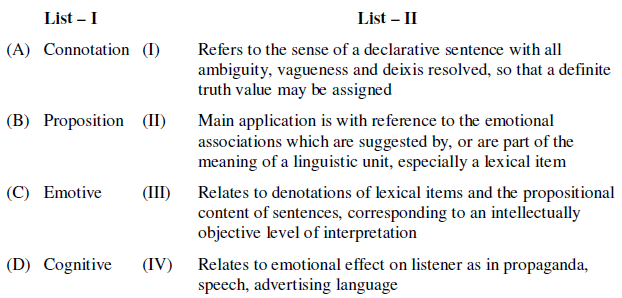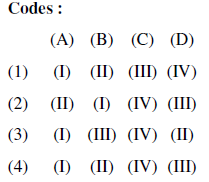LINGUISTICS
PAPER – II
Note : This paper contains fifty (50) objective type questions of two (2) marks each. All questions are compulsory.
1. While writing is derivative and represents an attempt at making a record of spoken language,
(1) sign language is derivative and hence not a natural mode of communication.
(2) sign language is a primary and an artificial mode of communication.
(3) sign language is a primary, natural mode of communication.
(4) sign language is derivative though a natural mode of communication.
2. Competence can be defined as
(1) What a native speaker speaks
(2) Knowledge of language
(3) relation between signifier and signified
(4) Sounds produced by a human being
3. Assertion (I) : Formal language is generated by a formal grammar.
Assertion (II) : Formal language must resemble natural language.
Codes :
(1) Only (I) is true, (II) is false.
(2) Only (II) is true, (I) is false.
(3) Both (I) and (II) are true.
(4) Both (I) and (II) are false.
4. Match the items in List – I with items in List – II.


5. Language faculty as a genetic endowment, that enables a species to have, to acquire and to use language, is
(1) unique to all primates
(2) unique to all animals
(3) unique to only humans
(4) unique to all living beings
6. When someone speaks there is not just a message, a question, or a request in the words, but
(1) there is no information about the speaker and the speaker’s attitude in the voice and the style.
(2) there is information about the speaker and the speaker’s attitude in the voice and the style.
(3) there is information about the speaker though no information about the speaker’s attitude in the voice and the style.
(4) there is no information about the speaker though there is information about the speaker’s attitude in the voice and the style.
7. Assertion (I) : The information encoded in a word is fairly complex.
Assertion (II) : A word is not associated with different kinds of information.
Codes :
(1) Both (I) and (II) are false.
(2) (I) is true, but (II) is false.
(3) (I) is false, but (II) is true.
(4) Both (I) and (II) are true.
8. Euphemism refers to
(1) the use of forbidden expressions
(2) the use of performance forms
(3) the use of word blends
(4) the use of nice sounding alternatives to existing forms
9. Assertion (I) : Design features of language include ‘displacement’ ‘duality of patterns’ and ‘vocal auditory channel’.
Assertion (II) : Design features distinguish between natural human language and forms of communication used by other species.
Codes :
(1) (I) is true (II) is false
(2) (I) is false (II) is true
(3) Both are false
(4) Both are true
10. Assertion (I) : A succession of speech varieties without major linguistic boundaries is called a dialect continuum.
Assertion (II) : Dominance of dialectal features delimiting the linguistic area is marked as isoglosses.
Codes :
(1) Both are true
(2) Both are false
(3) (I) is true and (II) is false
(4) (II) is true and (I) is false
11. Match the items in the List-I with those of List-II.


12. Nasalization refers to the process where
(1) the air is released through the nasal passage
(2) the air is released through the oral as well as the nasal passage
(3) the air is partially released through the nasal passage
(4) the air is not released through the oral chamber
13. Fundamental tone refers to
(1) level tone
(2) harmonics
(3) formants
(4) frequency of vibration of vocal cords
14. Identify the correct order in terms of sonority, from high to low sonority :
(1) open vowels → close vowels → fricatives → stops
(2) close vowels → open vowels → stops→ fricatives
(3) close vowels → open vowels → fricatives → stops
(4) fricatives → open vowels → close vowels → stops
15. An ordering convention that uses the parenthesis notation indicating optional elements is called
(1) conjunctive ordering
(2) extrinsic ordering
(3) no ordering
(4) disjunctive ordering
16. A theory of phonology in which morphological and phonological rules are brought together within a single framework, where largely phonology operates together with the word-formation rules in a cyclic fashion to define the class of lexical items in a language,
is called
(1) Morphophonology
(2) Phonomorphology
(3) Phonological lexicology
(4) Lexical phonology
17. Assertion (I) : An emic approach to intonation, for instance, would describe only those features of the pitch pattern which are used by a language to signal meanings.
Assertion (II) : An etic approach would, on the other hand, describe the utterances pitch movements more minutely, regardless of whether the features are used to signal meanings or not.
Codes :
(1) Both (I) and (II) are correct
(2) (I) is correct, (II) is wrong
(3) (I) is wrong, (II) is correct
(4) Both (I) and (II) are wrong
18. The r in the word ‘children’ can be referred to as
(1) Zero morph
(2) Empty morph
(3) Bound morph
(4) Allomorph
19. If a morph can be analysed into more than one morpheme, it is called
(1) Compound morph
(2) Bound morph
(3) Portmanteau morph
(4) Complex morph
20. Assertion (I) : In lexicalist hypothesis a class of lexical rules governing word-formation is distinguished from the set of syntactic transformations.
Assertion (II) : Lexicalist hypothesis bans category changing rules from the grammar – disallowing a verb or adjective from being transformed into a noun, etc.
Codes :
(1) Both (I) and (II) are correct
(2) (I) is correct, (II) is incorrect
(3) (I) is incorrect, (II) is correct
(4) Both (I) and (II) are incorrect
21. Assertion (I) : In the sentence ‘The boy gave a book to the girl’, ‘the book’ is the direct object.
Assertion (II) : In the sentence ‘The fat man gave the foolish man, a pink flower’, ‘the foolish man’ is the indirect object.
Codes :
(1) (I) is true, (II) is false
(2) (I) is false, (II) is true
(3) Both (I) and (II) are true
(4) Both (I) and (II) are false
22. ‘Infinite number of sentences from a finite set of rules’, forms
(1) the transformational component
(2) the Generative component
(3) the phonetic form
(4) the logical form
23. Which of the following is not a constraint attributed to Ross ?
(1) Complex NP constraint
(2) Sentential subject constraint
(3) Coordinate structure constraint
(4) NP accessibility constraint
24. Assertion (I) : Coordinate structures are those with a coordinate conjunction like ‘and’, ‘but’, etc.
Assertion (II) : An element can be moved out of the coordinate structure.
Codes :
(1) Both (I) and (II) are true
(2) Both (I) and (II) are false
(3) (I) is false, (II) is true
(4) (I) is true, (II) is false
25. ‘The boy had been eating the cake’ is a
(1) Present progressive sentence
(2) Past progressive sentence
(3) Past perfect progressive sentence
(4) Present perfect progressive sentence
26. “ ‘Snow is white’ is true if and only if snow is white” is an example of
(1) Homonymy
(2) Implicature
(3) Truth condition
(4) Speech act
27. Which of the following is an example of discourse/text deixis ?
(1) the former/the following
(2) this/that
(3) now/then
(4) I/you
28. Assertion (I) : The open class of words belong to the categories of noun, adjective, verb and adverb.
Assertion (II) : The open class of words belong to the categories of pronoun, preposition/postposition, conjunction and interjection.
Codes :
(1) Both (I) and (II) are correct
(2) (I) is correct and (II) is wrong
(3) (I) is wrong and (II) is correct
(4) Both (I) and (II) are wrong
29. Which of the following is not correct ?
(1) ‘lion’ is a hyponym of ‘animal’
(2) ‘bird’ is a superordinate of ‘sparrow’
(3) ‘lion’, ‘dog’, ‘cow’ are co-hyponyms of ‘animal’
(4) ‘body’ is a meronym of ‘arm’
30. Match the items in List-I with those in List-II and choose the correct code.


31. Languages change, but they actually change quite slowly. This results into
(1) a complete loss of the ability to communicate with all generations of speakers
(2) a partial loss of the ability to communicate with all generations of speakers
(3) the ability to communicate successfully with all generations of speakers of our own language variety is maintained
(4) the ability to communicate successfully with one generation of speakers is lost while it is maintained to communicate successfully with the next generation of speakers.
32. Designed to account for observed similarities in the output of different grammars claiming that the grammars in question share at least a subset of their features because they have acquired these features through inheritance from a common ancestor, the hypothesis is
(1) Family tree hypothesis
(2) The genetic hypothesis
(3) The regulation hypothesis
(4) P.D. Gune Hypothesis
33. Assertion (I) : Languages which are genetically related have a common ancestor.
Assertion (II) : Non-genetic links between languages cannot be established using comparative linguistic techniques.
Codes :
(1) Both (I) and (II) are correct
(2) Both (I) and (II) are wrong
(3) (I) is correct, but (II) is wrong
(4) (I) is wrong, but (II) is correct
34. The longer two languages have diverged, which of the following is true ?
(1) the easier it is to distinguish inherited lexical and grammatical features from accidental resemblances.
(2) the easier it is to regard them as genetically related.
(3) the harder it is to distinguish inherited lexical and grammatical features from accidental resemblances, borrowing effects, and typologically driven convergences.
(4) the better it proves the accidental resemblance between the two.
35. Assertion (I) : The comparative method refers to the standard comparative technique of comparing a set of forms taken from cognate languages in order to determine whether a historical relationship connects them.
Assertion (II) : If there were such a relationship, this analysis would then be used to deduce the characteristics of the ancestor language from which they were assumed to have derived.
Code :
(1) Both (I) and (II) are false
(2) (I) is true, but (II) is false
(3) (I) is false, but (II) is true
(4) Both (I) and (II) are true
36. In his classic paper “India as a linguistic area”, Emeneau did not discuss a language family that is
(1) Indo-Aryan
(2) Dravidian
(3) Austroasiatic
(4) Tibeto-Burman
37. In morphological change the following can be a major source
(1) Stress
(2) Analogy
(3) Assimilation
(4) Pejoration
38. Which of the following South Asian languages is a V2 language ?
(1) Sindhi
(2) Punjabi
(3) Kashmiri
(4) Maithili
39. Assertion (I) : SOV languages mostly show certain typological characteristics such as post positions, case systems and left-branching structures in which modifiers precede their heads.
Assertion (II) : However, Indian languages mostly show SVO word order.
Code :
(1) (I) is true but (II) is false
(2) (I) is false but (II) is true
(3) Both (I) and (II) are true
(4) Both (I) and (II) are false
40. Which of the following is not true for Grimm’s law that it converted ?
(1) earlier voiceless stops to voiceless fricatives
(2) voiced stops to voiceless stops
(3) voiced aspirates to plain voiced stops
(4) voiceless aspirates to voiced stops
41. A technique in language teaching and learning for identifying, classifying and systematically interpreting the unacceptable forms produced by someone learning a foreign language
(1) Transfer analysis
(2) Contrastive analysis
(3) Discourse analysis
(4) Error analysis
42. The concepts of restricted and elaborated codes were proposed by
(1) William Labov
(2) Basil Bernstein
(3) Charles Ferguson(4) Joshua Fishman
43. The concept of Notional Syllabus was given by
(1) Pit corder
(2) David Crystal
(3) D.A. Wilkins
(4) R.H. Robins
44. A term used for describing incomplete language learning is called :
(1) Fossilization
(2) Collocation
(3) Acculturation
(4) Diffusion
45. Bilinguals who attribute identical meanings to corresponding lexical units in two languages are called
(1) Co-ordiante bilinguals
(2) Compound bilinguals
(3) Passive bilinguals
(4) National bilinguals
46. Range of languages or varieties of a language available for use by a speaker to perform social roles is called
(1) Creole
(2) Competence
(3) Verbal Repartoire
(4) Langue
47. A group of people who constitute a regional and social unit by virtue of sharing a common code is called
(1) Bilingual community
(2) Speech community
(3) Verbal community
(4) Cross linguistic community
48. A linguistic variety defined on social (as opposed to regional) grounds e.g. correlating with a particular social class or occupational group is called
(1) register
(2) dialect
(3) idiolect
(4) sociolect
49. Language variety which characterises linguistic features involving mediating norms of social behaviour in relation to notions such as courtesy, deference and distance evinces
(1) Grammatical phenomena
(2) Multilingual phenomena
(3) Lexical phenomena
(4) Politeness phenomena
50. A variety of language defined according its use in domains such as science, religion, philosophy etc. is called
(1) Langue
(2) Register
(3) Parole
(4) Lemma
Latest Govt Job & Exam Updates: